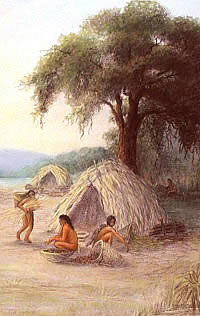
Encampment of native peoples in the Plateaus and Canyonlands, as envisioned by artist/archeologist Reeda Peel. Click to view full image.
|
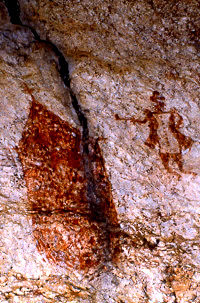
Rock art of native artists often documented events that rocked their world view, such as the coming of Spanish soldiers and priests and the establishment of missions in their lands. This panel, from a rock shelter (41VV77) in the Lower Pecos area of southwest Texas, shows a figure dressed in European clothing, a structure topped by a cross, and horsemen—possibly Spanish vaqueros—with a herd of cattle. TARL archives. (Click to see full image.)
|
By the 1670s, the Apache
were pushing south off the Southern Plains due to Comanche
intrusion into their former homeland. This pattern—interlopers moving into territory occupied
by others—can be seen time and again in the history
of the native peoples of Texas after contact. |

Aggressive Plains groups—first the Apache and then the Comanche—swept into Texas, pushing indigenous peoples to the south and into Mexico. The Plains warrior shown, likely a Lipan Apache in the Hill Country area, was painted by German artist Fredrich Richard Petri circa 1850.
|
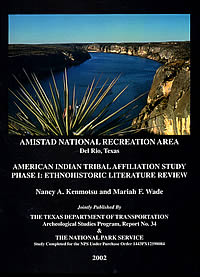
Cover of report on the ethnohistory of the
Amistad Recreation Area by Nancy Kenmptsu and Mariah Wade (2002,
Texas Department of Transportation and National Park Service)
from which much of the information in these exhibits is drawn.
|
|
Like whispers on the wind, the many names
of native groups that roamed the Texas Plateaus and Canyonlands
are haunting in their strangeness, the ephemeral reminders of a vastly
different, yet relatively recent, time. The Historic
Period was a time of conflict and
cultural upheaval for Texas' native groups, as new peoples—both
Indian and European—pushed into the area, intent on establishing
a presence, exploiting natural resources, or, in many cases, fleeing
in the advance of aggressors.
Some relative newcomers to the region,
such as the Apache, Comanche, and Kiowa, were established, aggressive
and large enough to withstand the depredations brought on by forced
migration and European diseases. But hundreds of smaller groups native to the region were
pushed about and preyed upon to the point of extinction.
Today, the names and fleeting accounts of some of these native groups, dutifully recorded by Spanish explorers,
missionaries, and government officials, are all
that remain today of what must have been a rich and colorful tapestry
of cultures.
During the Historic Period (the time of written records;
beginning roughly in the mid-1500s in the region), literally hundreds of groups
of native peoples were in flux across the southeastern United States
and in the area that is now Texas and northern Mexico.
Explorers, missionaries, and government officials, scouting new
territory for Spain and France, encountered band after band of
native peoples in the area that is now Texas. Scribes and soldiers
enlivened their official diaries and journals with descriptions of
the aboriginal peoples and their lifestyles. Spanish priests lived
or traveled among some of the groups and, at mission outposts, compiled
long lists of the natives who they baptized and hoped to convert
to Christianity and a settled lifeway. Some observers made note of the natural resources that the Indians
hunted and gathered, even as they were being taught to grow corn
and other crops at the missions.
Accounts such as these provide brief
but often compelling glimpses of the myriad native groups traversing
the region. Limited and culturally biased though these records may
be, they nonetheless contain the earliest written accounts of native
peoples practicing traditional lifeways in what is now Texas. They
are, in effect, our bridge from the near-present to the prehistoric
past—in some cases, the eye-witness accounts of the activities
we see represented in artifacts and archeological sites.
By the 1670s, the Apache were pushing south off the Southern Plains
due to Comanche intrusion into Apache territory, further altering
the cultural landscape. This pattern—interlopers moving into
territory occupied by others—can be seen time and again in
the history of the native peoples of Texas after contact. The disruption
of native lands, along with epidemics, and other disastrous effects
of colonization, resulted in the loss of many of these groups. In other cases, groups found comfort in joining
other larger groups—even the Apache. And, in some cases, people
moved to remote regions of northern Mexico and later became part
of the population that still occupies those lands today. For all these reasons, dozens of native groups dropped from sight in a relatively short period, their names absent in later reports written by Spanish priests and soldiers.
TxDOT archeologist Nancy
Kenmotsu and University of Texas anthropologist Mariah Wade have intensively researched the southwest portion of the
Plateaus and Canyonlands region to produce an ethnohistory of the
Amistad Recreation area. They also reviewed numerous late period archeological
sites in the region, particularly those with arrow points, stone
tipi rings, or historic rock art which might be linked to historically
documented native encampments. The results of their work, compiled
in a 2002 report, provide much of the data for
this exhibit. Wade also has researched the native groups of the Edwards Plateau, mining the relatively few accounts of explorers and priests who traversed the region for insights about these little-known peoples.
Their findings show that well into the Historic Period, native groups of the Plateaus and Canyonlands
region continued practicing a traditional hunting-gathering, mobile lifeway, subsisting
on the varied plants and animals of the plateau and desert lands
to the west, and making periodic forays into neighboring areas to
hunt bison or harvest fruits and nuts in season. Several known groups
who frequented the area, including the Jumano and Apache, were known
to have periodically planted crops along the Nueces and other rivers to supplement their diet.
That hunting and gathering continued to be the predominate lifeway, however, points up the skillful and ingenious adaptation strategies practiced by native peoples over thousands of years in the Plateaus and Canyonlands.
The following sections provide a brief look at three of the region’s
native groups: Gueiquesale, Kiowa,
and Apache. Two—the
Apache and Kiowa—were able to withstand, by various means,
the forces that drove other groups to extinction. Today, they still
maintain certain tribal identities and work to preserve traditional
customs. Less successful, the Gueiquesale were devastated
by disease and other pressures and ultimately faded into history,
like most of the hundreds of native groups who once roamed Texas.
The Native Peoples exhibits begin with Making
Sense of the Evidence: Old Records and Archeological Remains,
a look at the various types of information used to form a picture
of the native peoples and their lifestyles several hundred years
ago. Sections on the Gueiquesale, Kiowa,
and Apache offer readers a cross-section
of the variety and uniqueness of the Native American stories and
a view on how these groups accommodated—or failed to accommodate—change,
as the Spanish and later Anglo-Europeans came to settle in their
homelands. The Credits & Sources section
lists provides sources consulted during research and suggestions for further reading.
Additional information on Texas’ native peoples is available in several other exhibits on Texas Beyond History. The Historic
Encounters layer of the main Plateaus and Canyonlands
map is an annotated map denoting sites of missions and a variety
of other historic places in the region. The
Passing of the Indian Era in the TBH Texas
Frontier and Forts exhibits traces the demise and removal of native
peoples in the state as white settlers surged into the state.
See also Native Peoples of the South Texas Plains, a parallel regional exhibit set, for an in-depth look at the Coahuiltecan groups of south Texas and northeastern Mexico.
In forthcoming exhibits over the next two years, the
Prehistoric Texas Project will examine other historic native groups
in adjacent regions of the state, including the Comanche
and Jumano (who also ranged over portions of the Plateaus and Canyonlands),
as well as more localized groups, such as the Coalhuiltecans of the
Rio Grande Plains and the Alabama Coushatta and Karankawa of the
Texas coastal areas.
|
Names of native groups in the region in late 1600s
and 1700s:
Ape, Arame, Bagname, Bibit, Babole, Catujano, Ervipiame,
Geniocane, Gueiquesale, Jumee, Machome, Manos Prietas, Ocane, Pachal,
Papaya, Pinanaca, Saesser, Siano, Teaname, Teimamar, Terocodame, Tilijae,
Tilpayay, Yorica.
|
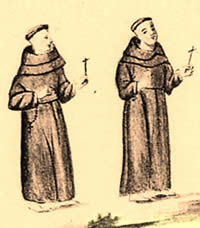
Spanish priests, sent into New Spain from the late 1500s to late 1700s to establish missions for the Indians, recorded their observations of the native peoples they hoped to convert to Christianity.
|
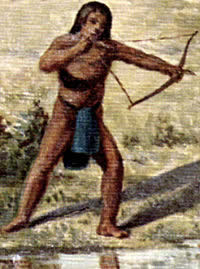
Native peoples engaged in traditional activities were documented in text accounts as well as in paintings by artists on the frontier. Detail from scene of Lipan Apaches in the region, painted by Fredrich Gentilz during the 1840s, original painting, Witte Museum.
|
These records contain
the earliest written accounts of native peoples practicing
traditional lifeways in what is now Texas. They are, in effect,
our bridge from the near-present to the prehistoric past-in
some cases, the eye-witness accounts of the activities we see
represented in artifacts and archeological sites. |

Indians on the move, with possessions loaded onto travois-sled-like carriers pulled by horses. In earlier days, dogs hauled the camp equipment from site to site.
|
|








